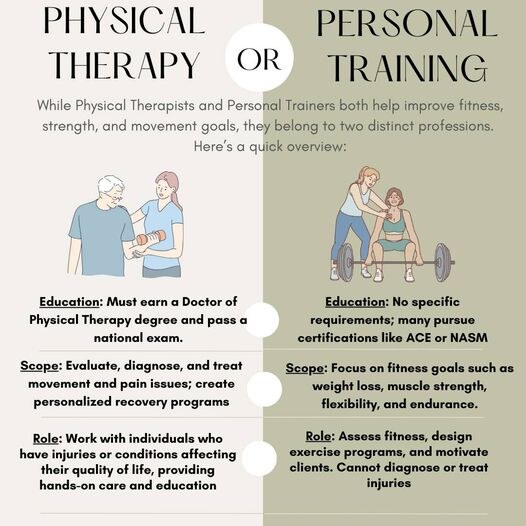Physical therapy and personal training both play essential roles in helping people improve their fitness, strength, and movement. While they belong to distinct professions with different scopes of practice, education, and training, both can work together to offer comprehensive care and achieve optimal health outcomes. Understanding their differences and how they complement each other can help you make informed decisions about your health and wellness journey.
The Role of Personal Training
Education and Certification: Personal trainers are fitness professionals who work one-on-one with clients or in small groups to achieve specific health and fitness goals. While there are no specific educational requirements to become a personal trainer, many pursue certifications from accredited agencies such as the American Council on Exercise (ACE) or the National Academy of Sports Medicine (NASM). Certifications in first aid and the use of an automatic external defibrillator (AED) are also commonly required.
Scope of Practice: Personal trainers focus on:
- Assessing a client’s fitness level.
- Designing customized exercise programs to achieve goals such as weight loss, muscle strengthening, flexibility, endurance, and improved sports performance.
- Instructing clients on the safe use of exercise equipment and proper exercise techniques to avoid injury.
- Motivating and supporting clients to stick to their programs.
Personal trainers cannot diagnose injuries or health conditions or prescribe rehabilitation programs. Instead, they work alongside clients to enhance their fitness levels and overall health.
The Role of Physical Therapists vs Personal Training
Education and Certification: Physical therapists (PTs) are licensed health professionals who must earn a Doctor of Physical Therapy (DPT) degree from an accredited program, which typically takes three to five years to complete. They must pass the National Physical Therapy Examination and fulfill state licensure requirements. PTs also complete continuing education hours to maintain their licenses.
Scope of Practice: Physical therapists:
- Evaluate, diagnose, and treat movement and pain issues.
- Create personalized recovery programs to improve movement, reduce pain, and prevent disability.
- Treat a wide range of conditions, including back and neck pain, sports injuries, post-surgical healing, age-related issues, joint problems, and more.
- Use various tools and procedures, including hands-on treatment, stretches, exercises, and modalities such as heat or cold therapy, ultrasound, electrical muscle stimulation, and more.
PTs also teach clients home exercise programs to maintain progress and reduce the risk of re-injury after their in-clinic program ends.
How Physical Therapy and Personal Training Work Together
Combining the expertise of physical therapists and personal trainers can provide a comprehensive approach to health and fitness. Here’s how they complement each other:
1. Integrated Care: Physical therapists and personal trainers can collaborate to ensure a seamless transition from rehabilitation to fitness. After completing a physical therapy program, clients can continue working with personal trainers to maintain and further enhance their fitness levels.
2. Personalized Programs: Both professionals design personalized programs tailored to individual needs. A physical therapist can create a rehabilitation plan to address specific injuries or conditions, while a personal trainer can develop a fitness program to achieve broader health goals.
3. Prevention and Maintenance: Physical therapists help prevent future injuries by addressing underlying issues and improving functional mobility. Personal trainers focus on maintaining and building on these improvements, promoting long-term health and fitness.
4. Enhanced Motivation and Support: Working with both a physical therapist and a personal trainer provides clients with a well-rounded support system. Physical therapists offer medical expertise and rehabilitation, while personal trainers provide motivation and accountability to stay on track with fitness goals.
Why Choose The Human Performance and Wellness Center and The Fitness Zone?
At The Human Performance and Wellness Center and The Fitness Zone, we understand the importance of integrating physical therapy and personal training to provide the best care possible. Since 2007, we have been offering transformative physical therapy, personal training facility and other cash based services to clients of all ages. We also collaborate closely with certified personal trainers at The Fitness Zone, ensuring a holistic approach to health and wellness.
Our Commitment:
- Personalized attention and commitment to each client.
- Expertise of our highly trained staff.
- State-of-the-art facilities.
- Listening to client feedback and valuing their input to develop tailored plans.
We know how challenging it can be to perform even the smallest daily activities when experiencing pain and impaired movement. That’s why we work closely with our clients to develop personalized plans that meet their goals. By combining your knowledge of your body with our specialized training, we are confident in achieving optimum healing and improved function.
Conclusion
Both physical therapy and personal training offer unique benefits that can significantly enhance your health and wellness journey. By understanding their distinct roles and how they work together, you can leverage their combined expertise to achieve your fitness, strength, and movement goals.
At The Human Performance and Wellness Center, we are proud of the positive feedback we receive from our clients, highlighting how physical therapy has improved their lives. Contact us today to schedule a free screening and take the first step towards a healthier, more active life.



